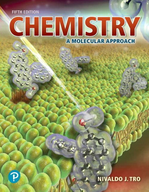?The values of \(\Delta G_{\text {f }}^{\circ}\) for the hydrogen halides become less
Chapter 19, Problem 96(choose chapter or problem)
The values of \(\Delta G_{\text {f }}^{\circ}\) for the hydrogen halides become less negative with increasing atomic number. The \(\Delta G_{\mathrm{f}}^{\circ}\) of HI is slightly positive. However, the trend in \(\Delta S_{\mathrm{f}}^{\circ}\) is to become more positive with increasing atomic number. Explain.
Text Transcription:
Delta G_f^circ
Delta S_f^circ
Unfortunately, we don't have that question answered yet. But you can get it answered in just 5 hours by Logging in or Becoming a subscriber.
Becoming a subscriber
Or look for another answer
